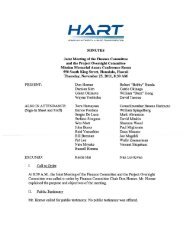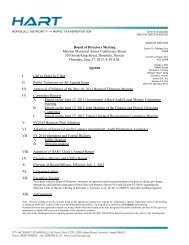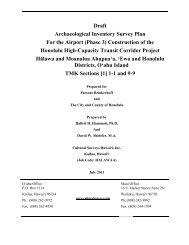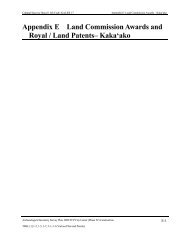4.12 Test Excavation 167 (T-167) - Honolulu Rail Transit Project
4.12 Test Excavation 167 (T-167) - Honolulu Rail Transit Project
4.12 Test Excavation 167 (T-167) - Honolulu Rail Transit Project
You also want an ePaper? Increase the reach of your titles
YUMPU automatically turns print PDFs into web optimized ePapers that Google loves.
Cultural Surveys Hawai‘i Job Code: KALIHI 23Kewalo Geographic Zone4.17 <strong>Test</strong> <strong>Excavation</strong> 170 (T-170)Ahupua‘a:LCA : 387<strong>Honolulu</strong>TMK #: 2-3-002:059Elevation Above Sea Level:UTM:Max Length / Width / Depth:Orientation:Targeted <strong>Project</strong> Component:USDA Soil Designation:1.48 m618864.7858 mE, 2355380.988 mN3.74 m / 0.93 m / 1.16 m230 / 50° TNGuideway ColumnFill land (FL)Setting: <strong>Test</strong> <strong>Excavation</strong> 170 (T-170) was located in the thruway of a parking lot,approximately 60.0 m southwest of Queen Street, east of Ward Avenue. There were no existingutilities in the immediate vicinity. T-170 was located on private property owned by VictoriaWard, Ltd. The excavation area was level with the surrounding land surface.Summary of Background Research and Land Use: Land Court Application 670 map 1indicates that T-170 was originally situated on a large parcel of land awarded to the AmericanBoard of Commissioners for Foreign Missions (ABCFM) as part of LCA 387. The LCAtestimonies indicated taro cultivation, fishpond farming, and salt production in the region. The1884 Bishop map of <strong>Honolulu</strong> to Kewalo indicates that T-170 was located within marsh landcalled Kukuluaeo, 60.0 m east of LCA 10463:1, awarded to Napela. An unimproved or plannedroadway is also depicted, extending northeast (mauka) to southwest (makai) within 8.0 m of T-170. The roadway is also depicted on the 1887 Wall map of <strong>Honolulu</strong> along with three structuresin the vicinity of T-170. The structures were located approximately 140.0 m northwest, 75.0 msouthwest, and 210.0 m southwest of T-170. The 1897 Monsarrat map of <strong>Honolulu</strong> depictsinfrastructure development immediately north of T-170 including a near-modern street grid withthe closest intersection being Queen Street and Cummins Street 90.0 m southeast and theCyclomere bicycle track 315.0 m north. Expanded urbanization in the vicinity of T-170 isdepicted throughout the series of twentieth century topographic maps and Sanborn fire insurancemaps.Few archaeological studies were conducted in the immediate vicinity of T-170. In 2000, CSHconducted archaeological monitoring for Ward Village Phase II (Ward Theaters), approximately140.0 m southeast of T-170. A buried A-horizon and naturally-deposited pond sediments weredocumented in portions of the project area but, no cultural resources were assigned (Winieskiand Hammatt 2001). In 2005, CSH conducted an archaeological inventory survey for the MoanaVista <strong>Project</strong> on Kapi‘olani Boulevard, located approximately 280.0 m east of T-170. No culturalresources were encountered (O’Leary and Hammatt 2006). In 2010, CSH conductedarchaeological monitoring for a Traffic Signal <strong>Project</strong> around the intersection of Queen Streetand Kamake‘e Street, which was located approximately 178.0 m southeast of T-170. Portions ofHHCTCP City Center (Section 4) AIS Report, Vol. IV C 799TMK: [1] 1-2, 1-5, 1-7, 2-1, 2-3 (Various Plats and Parcels)
















